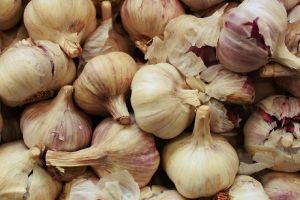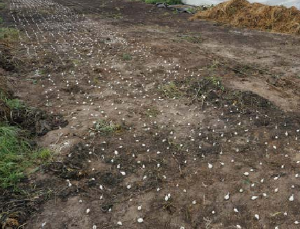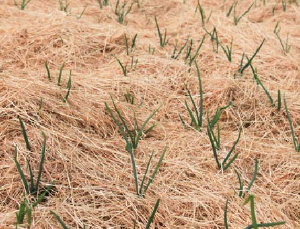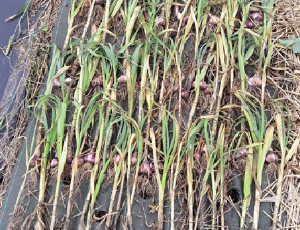Garlic

Garlic is one of the longest crops in market gardening
market gardening : sowing bulbs in November and
harvested in July (in the open field or under cover), but it's still a profitable crop that requires little follow-up.
Preparing the soil
Garlic has no particular nutrient requirements; soil improvers from previous crops are sufficient. A bed of compost before planting makes planting easier. It may be possible to cover spring garlic with a tarpaulin before planting, but the bed should be loosened before planting.

Planting

Garlic is not sown; the cloves are planted between November and December for autumn garlic and between January and March for spring garlic. The seed is removed by hand just before planting. A large clove will give a large head of garlic. So keep the outer cloves for storing garlic, and the smaller central cloves for making carnations in the spring. garlic in the spring. The latter can be planted more densely (45 to 50 per m²), on a bed of compost, by hand. They should be planted by hand, 2-5 cm deep, pointing upwards at a spacing of 15 x 15 cm. Finally, spread a layer of straw about 10-15 cm thick over all the beds.
Tip
If garlic is grown in a greenhouse, tomatoes or aubergines tomatoes or aubergines can be planted with it (you may need to harvest a little carnation in the transplanting areas).
Monitoring the crop
One or more manual weedings can be carried out if the perennials penetrate the straw and interfere with the crop. If not, then no further action is required.
Irrigation
Water requirements are not generally high, you can leave the crop unwatered unless the soil is too dry in too dry in June. Garlics do not appreciate excess moisture. It is at the time of emergence and bulbification that water requirements are highest.
Harvest

For storage garlic, harvesting is done by hand when conditions are dry, to prevent the stalks from rotting and it becomes impossible to pull on them without breaking them. break them. The harvested garlic is left on the ground and placed in bundles to dry for around five to six days. As garlic is garlic is sensitive to sunburn, so if the weather is very good avoid drying them outside or in a tunnel. Place them flat in a dry, well-ventilated room or in a crate in front of a fan for an average of ten days.
Tip
To dry in a greenhouse without worrying about sunburn: arrange the garlic so that the stems so that the stalks of one plant cover the cloves of the others!
Storage
For storage garlic, use ventilated crates in a dry, cool, well-ventilated cool, ventilated place. Peeling and topping are still possible.
Varieties
- Autumn garlic : White and violet garlic are ideal for green harvesting. Purple garlic is earlier, but both are more difficult to store.
- Spring garlic : Pink garlic has smaller cloves but keeps well.
Pests and diseases
- Foliage rust due to a wet spring is very common on garlic. There are no authorised organic control methods.
- Viral diseases and nematodes can be transmitted through the seed and gradually degenerate production. It is possible to use your own seed, but make sure you renew it periodically with certified disease-free seed.
Adapting to the soil and climate
Because of its fragile root system, garlic grows best in soil that best on soil that retains water (with a high percentage of clay), but percentage of clay), but with good drainage to prevent excess to avoid excess water.
Possible ITK variations
Like onions, broadcast sowing is possible, but yields are yields are 30% lower.
Photo gallery
Sources
- This page is based on the guide Introduction au maraîchage sol vivant from MSV Normandie
- Producing garlic in Occitania (Dephy) : https://geco.ecophytopic.fr/documents/20182/21720/Upload_2020-10-28_14-29-57-296.pdf
